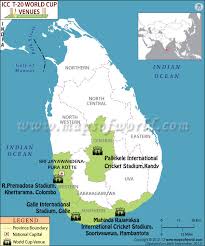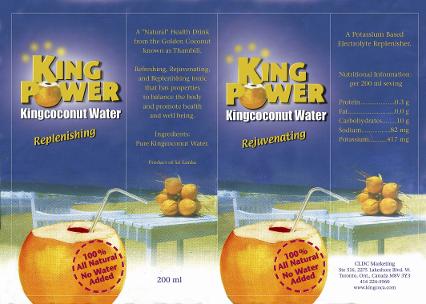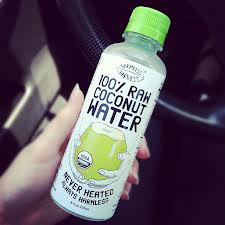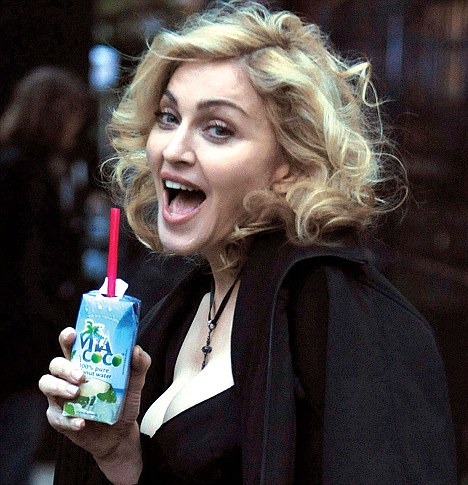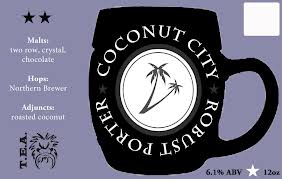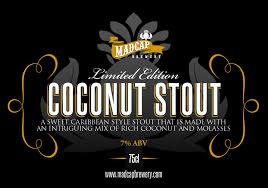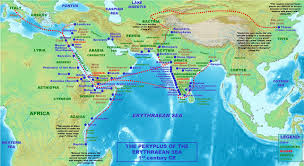"THE CHAMPAGNE OF COCONUT WATER"
SALES@KINGCOCA.COM
"To CREATE a NEW, ALTERNATIVE, GLOBAL, BUSINESS MODEL, based on ETHICAL PRINCIPLES, to LIBERATE
GLOBAL CONSUMERS from CORPORATE FOOD AND BEVERAGE TERRORISM, that are DECIMATING the
Developing World. "KING COCA" WILL BE THE GOLD STANDARD for (preferably Organic), coconut based
Beverages, that will result in:
1) Meaningful, Long Term Employment for our Fair Trade Global Farmer Suppliers
2) Financial Independence for our Global Home Distributors
3) Sustainable Economic Development for the entire " NUTRACEUTICALS RESEARCH COMMUNITY"
4) CREATE.....the World's BEST, vertically integrated, SUSTAINABLE Coconut Product Producer."
KING COCA BEVERAGE CORPORATION (KCBC)
By Dr. Mercola:
Jeff Volek, Ph.D., and registered dietitian and professor in the Human Science Department at Ohio State University, has done enormous work in the field of high-fat, low-carbohydrate diets, investigating how it affects human health and athletic performance.
Volek has published many scientific articles as well as several books, including "The Art and Science of Low Carbohydrate Living," and "The Art and Science of Low Carbohydrate Performance."
Both of these books were co-authored with Dr. Stephen Phinney, a physician and true pioneer in this field, who has studied low-carb diets even longer than Volek.
Starting out as a dietician, Volek was taught that low-fat diets were healthy and that saturated fats and cholesterol should be avoided. But in working with diabetics, he kept feeling that something was "off." Why should diabetics eat so many carbs?
"In essence, it drove me to want to understand metabolism and nutrition at a much deeper level," he says.
"I was also into self-experimentation ... I was at the time into very low-fat diets, thinking that was how I would optimize my own health. But I decided to experiment with a very low-carb diet."
Low-Carb Diets Can Benefit Athletes and Non-Athletes Alike
His experimentation began in the early '90s and, to his great surprise, his low-carb experiment proved to be anything but harmful. This fueled his passion for understanding how humans respond to diets that are very low in carbohydrates, and led him to continue his education.
He has now spent the last 15 years conducting research in this area, and the outcomes from most experiments have been very encouraging.
"The science continues to point in the direction that there are a lot of applications for these diets for a large number of people.
We're still sorting out a lot of the details, but clearly we need to change the way we feed Americans and the way we think about nutrition in order to reverse ... obesity and diabetes."
He's also done research on low- and non-fiber carb diets and athletic performance, and here too results have proved quite positive — despite running counter to everything he was taught about diet and performance in school, and in most of the scientific literature as well.
"It's been an interesting journey to say the least ...The things I was reading, the things I was taught were not really based on a lot of science, and were a lot of half-truths and misinformation, which still persist today,"he notes.
Is Your Diet Driving Your Metabolism in the Right Direction?
Most of the food (fuel) people eat these days is moving their metabolism in the wrong direction. The Westernized diet constantly biases you toward using more nonfiber carbs for fuel.
Most Americans are primarily burning glucose as their primary fuel, which actually inhibits their body's ability to access and burn body fat.
Healthy fat, meanwhile, is a far preferable sort of fuel, as it burns far more efficiently than carbs. As noted by Volek, humans evolved to primarily burn fat as fuel — not carbs — and yet that's not how we're feeding our bodies.
"As a result, we're running into a lot of metabolic problems, because we're constantly inhibiting our body's ability to burn fuel that we evolved to burn,"he says.
We all have to eat; we need fuel to live. Without generating ATP you cannot survive at all. The question is how to do that efficiently, without generating harmful reactive oxygen species (ROS), which can destroy your mitochondria and contribute to disease?
It's all about keeping your mitochondria healthy, and low-carb, high-fat dietstend to do that far more effectively than high-carb, low-fat diets.
Healthy Fat Is a 'Cleaner' Burning Fuel:
An indirect measurement included in one of Volek's books shows that when people burn fat as their primary fuel, their respiratory quotient can go down as low as 0.7 as opposed to 1, which suggests they're generating less carbon dioxide.
Regardless of the fuel your body burns, you're going to generate carbon dioxide and water. But when you burn fat, you generate 30 percent less carbon dioxide, suggesting it's a lot "cleaner" fuel.
"To use the term 'clean,' that's kind of a provocative term, but I think it is an appropriate one because ... there's a lot of 'exhaust' associated with burning carbs for fuel ... free radicals, reactive oxygen species ... That contributes to the metabolic problems we're seeing in this country."
Also, the most efficient way to train your body to use fat for fuel is to remove some of the sugars and starches from your diet. According to Volek, that's true for everyone, whether you're an elite athlete or a sedentary diabetic.
In essence, the reason why low-carb diets work so well is because it helps you escape this non-fiber, carb-based metabolism that depends on insulin levels to drive blood sugar into cells and use carbs for fuel.
Volek also introduces another term: "carb intolerance" — a metabolic impairment that you suffer from if you're insulin resistant or prediabetic. As noted by Volek:
"It really makes no sense if you're carb intolerant to be consuming half your energy from nonfiber carbs, and to be trying to force your body to burn more carbs."
Healthy Versus Harmful Fats
Most Americans consume harmful fats like processed vegetable oils, which will invariably make your health worse. So when we're talking about dietary fats, we're referring to natural, unprocessed fat, found in real foods such as seeds, nuts, butter, olives, avocado, or coconut oil.
Another good one is raw cacao — it's a phenomenal source of healthy saturated fats and many beneficial polyphenols. Fats are critical for a number of health reasons. They contribute to the formation of cellular membranes, for example, and it's really difficult to have good biological function with impaired cell membranes.
So, dietary fat serves two purposes: it serves as fuel; but it's also a foundational structural component of your biology.
If you're trying to lose weight, training your body to access your body fat is key, or else you cannot shed it. So if you're overweight, you want to teach your body to burn excess fat, and then, once you've reached your maintenance weight, the majority of fat your body will be burning is that from dietary sources.
But how do you make this conversion — to allow your body to become adapted to burn fat as your primary fuel — starting with any excess body fat you already have?
How to Make the Conversion from Burning Sugar to Burning Fat
In short, the key is to restrict non-fiber carbohydrates. It's important to make the distinction about which carbs we're talking about here, as vegetables are "carbs" too, but fiber carbs will not push your metabolism in the wrong direction — only the non-fiber ones will (think sugars and anything that converts to sugar, such as soda, processed grains, pasta, bread and cookies, for example).
You calculate the dangerous non-fiber carbs by simply subtracting the grams of fiber from the grams of total carbohydrate in the food.
Another important point is this:
"Your body can burn both carbs and fat, but your body will burn carbs first. As long as you're eating carbs, your body will try to burn those first. They're like the bully cutting in line. You may just think of them as kind of a throw-away nutrient too, because your body cannot store high levels of carb.
You have to try to oxidize them and burn them first. But if you're carb intolerant, which is highly prevalent in this country, you can't burn carbs, by definition, very well.
Your body then only has one alternative, and that's to convert the carbs you eat into fat. That happens to a greater extent to folks who are insulin resistant or carb intolerant. That really sets the stage for a lot of metabolic problems. Again coming back to how do you train the body to burn more fat; it all starts with removing the availability of carbohydrate because, as long as it's there, it's going to take precedence, and will simultaneously inhibit burning of fat.
These are very sensitive and exquisite mechanisms in place for this to work. You eat just a single meal of carbs and your fat-burning shuts down right away.
This is why a low- nonfiber carb diet works so well to shift fuel use over to fat. You restrict the amount of glucose and starches that you're consuming, and your body naturally shifts over to preferring fat for fuel. It does take some time to adapt to that. Your cells have to shift over their machinery to handle the increased levels of fat and lipid-based fuels. It takes a matter of weeks to get that adaptation.
But once it's there, they're fairly robust adaptations that don't just go away. This is why there is an adaptation period to a low-carb diet. It can be disrupted though if you reintroduce carbs. But a lot of the adaptations do remain."
Finding Your Ideal Carb Level
According to Volek, a level of non-fiber carbs that allows you to enter into nutritional ketosis (a metabolic state associated with an increased production of ketones in your liver; it's the biological reflection of being able to burn fat) is on average about 50 grams per day or less of digestible or absorbable carbohydrates. However, we all vary how we respond to the same food, so this is not an exact recommendation.
Some people can be in a full fat-burning state with full ketosis at a level of non-fiber carbs that's higher than 50 grams; maybe 70 or 80 grams. Others, especially if you're insulin resistant or have type 2 diabetes, may require less than 40 grams or even 30 grams per day.
Again, it bears repeating that when we say carbohydrates, we're referring to non-fiber carbs only. If you look at the nutrition facts on a processed food package, it will list total carbs, and that's not what we're talking about. Don't get confused about this or you'll get really nervous. You do need carbs, but you need most all of them from vegetables.
By volume, vegetables are not very calorie-dense. You could have an 85 percent fat diet, and the volume of the fat would be one-tenth the volume of the vegetables you're eating.
To find your personal carb limit, it's important to actually measure your ketones, which can be done either through urine, breath, or blood. This will give you an objective measure of whether or not you're truly in ketosis, rather than just counting the grams of carbohydrates you consume.
"That even varies within a person over time," Volek says. "You may be able to tolerate more carbs when you're in your 20s, but suddenly now you're in middle age and the same level of carbs is resulting in a few extra inches on your waist, your blood sugars are creeping up, you now have prediabetes, or worse.
The appropriate level of carb for an individual is bit of a moving target, but it is a very important element to personalizing a diet, which I think is fundamental to this idea of personalized nutrition. It's finding the appropriate level of carb for you at any given point in your lifespan that allows you to maintain health."
Research has shown that ketosis is a very safe and a therapeutic metabolic state to be in, especially if you're diabetic or suffering from carb intolerance. But there are people who are naturally very insulin sensitive and carb tolerant that don't need to be in ketosis to thrive. So there's certainly room for flexibility, depending on your individual situation.
Ketogenic Diet Can Benefit Many Chronic Health Problems
Beyond insulin resistance and type 2 diabetes, there are a number of applications for a well-formulated ketogenic diet, including epileptic seizures, especially in kids who are unresponsive to drugs, and neurological conditions such as Alzheimer's and Parkinson's. Cancer is another area where ketogenic diets show great promise.
"I think that is the next frontier of ketogenic diets," Volek says. "There are multiple reasons why many cancers would benefit from a ketogenic diet, not just the decreased glucose availability influx (which many tumors depend on) but also the lower insulin response and less inflammation, as many tumors thrive in a pro-inflammatory environment.
There are multiple potential mechanisms by which a ketogenic diet would benefit, including epigenetic effects. We now know that the principal ketone body, beta hydroxybutyrate, is more than a metabolite. It's more than just an alternative fuel for the brain.
It acts like a hormone or a potent signaling molecule that affects gene expression, including upregulating genes that are protective against oxidative stress and enhance the antioxidant status.
Our knowledge and perspective on ketosis is expanding almost daily. It's all pointing toward positive health effects, which is quite interesting considering that for the last three or four decades, we've been demonizing ketones because we only associate it with ketoacidosis."
Other benefits include the resistance to sugar and other food cravings, as you're never that hungry once you've made the shift. Mental clarity is another great boon. According to Volek, the U.S. military is showing great interest in ketones for this reason — along with the fact that it boosts physical stamina and endurance.
Being an efficient fat burner may also predispose you to a longer life. Dr. Ron Rosedale told me many years ago that the single most important variable for controlling the aging process is the ratio of fat versus carbohydrate you burn. The more fat you burn, the slower you’re going to age in general. More recent research supports this notion.
How Ketogenic Diet May Promote Longevity and Increased Muscle Mass
Recent research has found about a dozen genes associated with longevity. The primary function of one of these genes is to cripple the degradation of branched-chain amino acids, such as leucine, which can be useful for building muscle mass. Interestingly, in one of his books, Volek mentions that ketones share a close structural similarity to these branched-chain amino acids, and seem to be preferentially metabolized.
In other words, ketones spare those branched-chain amino acids, leaving higher levels of them around, which promotes longevity and increased muscle mass.
"We learned a lot about ketogenesis from the classic work done by people in the '60s studying starvation ketosis. One of the reasons why we can survive so long without food is we enter into ketosis, and ketosis spares protein breakdown. One of a more consistent effect we see in people on a ketogenic diet is that leucine levels go up in the blood, because they're not being oxidized to the same level.
Ketones are sparing oxidation and breakdown of important structural proteins, and therefore their levels or concentrations in the blood increase and allow them to do other important signaling-type functions.
I do see a very positive interaction here with nutritional ketosis and protein metabolism in general in sparing of the branched-chain amino acids in particular, which are unique in that they are a preferential fuel, unlike other amino acids, which don't really serve as a fuel substrate," Volek explains.
The Importance of Eating Moderate Protein
There's also a "sweet spot" regarding protein. You don't want more protein than your body actually needs. As noted by Volek, this is an important point because there's a common misconception that low non-fiber carb diets are high-protein diets. In reality, a ketogenic diet must actually be moderate in protein because excessive protein is anti-ketogenic.
On the other hand, you don't want to consume too little protein, as this may push you into a negative nitrogen balance. As a general rule, I recommend eating one-half gram of protein per pound of lean body mass per day, which for most sedentary folks is 40 to 70 grams, but this may be higher for athletes and larger individuals.
The best approach is to measure ketosis to know you are not over-consuming protein. For details on how to calculate this, please see my previous article, "The Very Real Risks of Consuming Too Much Protein."
"It's also important to maximize the quality of the protein," Volek says. "I am a general proponent of high-quality protein sources [such as] whey protein. Most animal sources of protein maintain these essential amino acids [discussed above].
I do think, with the potentially unique characteristics of leucine and branched-chain amino acids, we may discover that it's beneficial to include extra leucine even within a context of a ketogenic diet ... Especially if you're an athlete wanting to enhance lean body mass, there could be some benefit to specific use of leucine in particular after exercise or even before exercise ...
I generally think including all three [is best]. Leucine is a potent stimulator of mTOR and protein synthesis in skeletal muscles. It's one thing to turn on the machinery, but you still have to have the building blocks in order to build proteins. I do think it's important that you have full complement of the essential amino acids to make sure that you have all the material there to take advantage of the signaling effect of leucine."
Low-Carb Benefits for Athletes
The dogma in sports nutrition for the last four decades has been that in order to perform at a higher level and recover adequately, athletes need to consume high amounts of (non-vegetable) carbs before, during, and after exercise. However, in more recent years, the understanding of how low-carb diets can augment performance in certain athletes is starting to catch on.
It has certainly gained a great deal of traction in the ultra-endurance world, where athletes are exercising continuously for several hours.
"To be quite frank, they're challenged from a fueling perspective," Volek says, "because if they're eating carbs, they're inhibiting their ability to burn fat optimally. They're putting themselves in a situation where they're increasingly dependent on providing more carbs.
You can only store a limited amount of carbs in your body as glycogen, about 2,000 kilocalories, and if you're exercising for more than a couple of hours, you're burning through the majority of that stored carbohydrate.
That's when an athlete hits the wall. We know that's associated with obvious decrements in performance. How do you avoid that? You can carb-load. That's been the traditional recommendation; to try to pack even more carbs into your muscles ... but that will only delay exercise fatigue by a half hour or so. That doesn't really solve the problem.
It actually exacerbates the problem in some ways. The alternative is to train your body to burn more fat. If you're burning fat and sparing carbohydrates, you don't hit the wall. That's one of the most commonly perceived benefits of a low-carb diet for athletes."
Athletes who adopt this strategy can become exceptionally good at burning fat. Even if they're not eating calories during exercise, lean athletes have at least 20,000 to 30,000 kilocalories on their body in the form of adipose tissue that they can access during exercise. That's more than enough to finish even a 100-mile race. So from a fueling perspective, it makes sense that you'd want to burn more fat as opposed to carbohydrate.
Ultra-endurance athletes who have switched to low-carb, high-fat diets are now winning races and, in some cases, setting new course records. They're also experiencing other benefits, such as speedier recovery rates, improved metabolic health, and a leaner body composition.
More Information
Mounting evidence suggests low- non-fiber carb, high-fat diets may be the key that many people have been looking for, as it solves more than one problem. Not only does it help you shed excess body fat, it does so while simultaneously improving metabolism, boosting overall energy levels, and promoting optimal health and maximizing longevity in a number of different ways.
It can also help ward off neurological dysfunction, boost mental clarity, and improve athletic performance.
For those who struggle with insulin resistance or diabetes, it's certainly one of the most efficient ways to reverse the condition. Even those suffering with more serious conditions, such as cancer, may reap significant benefits.
To learn more, I highly recommend picking up one or both of Volek's books — "The Art and Science of Low Carbohydrate Living," and "The Art and Science of Low Carbohydrate Performance" — the latter of which is geared toward athletes in particular.
Preamble:
This report targets and identifies potential introductory market opportunities located within the Greater Toronto Area. It explores and develops a "grass roots" campaign designed to introduce King coconut water into the local area. The introductory campaign outlined herein is designed to create an initial start-up demand of consumer acceptance for King Coca that will fund and support the expansion this project and its allied products into the national distribution network. At the time of writing this document, some technical production issues are in the process of being evaluated and resolved.
Coconut Water: A Definition:
When you break the coconut, you get a liquid. This is called water. When you take the white flesh of the coconut and grind it and squeeze the juice out, this is coconut milk. What distinguishes King coconut water from all other variants of the fruit is that the âKingâ variety is a hybrid developed in the 18th century for its enhanced therapeutic and refreshment properties. Under modern day analysis, the elements found in all coconut waters is the
essentially the same, however, there is a markedly higher concentration of isotonic and electrolytic compounds found only in the King coconut variety that make it particularly attractive as a hot-weather refreshment, a sports enhancement beverage, and potentially a health food supplement. When supported by appropriate technical data, and properly promoted, King Coca will be able to carve out a unique place amongst other health-oriented and related dietary products. The beneficial and nutritive values of the King coca variety has been known for literally centuries to the local Sri Lankan and South Asian populations and with such high migrations and concentrations of these people into the GTA region, it is a natural market simply waiting to be capitalized.
Overview:
Coconuts, nutrition and Sri Lanka (formerly called Ceylon) have long been associated with one another. The coconut, although found in many primary and subspecies throughout the tropical and sub-tropical world, has a particular affinity for the climate and soil conditions unique to Sri Lanka. Coconut is the most widely grown plantation crop in Sri Lanka, occupying about 416 000 hectares of the total area of about 6.5 million ha. It is important in the daily diet of the average Sri Lanka, and has an estimated per capital consumption of 110 nuts/year. Around 80% of the
estimated total production is consumed domestically. About 135 000 persons are directly or indirectly employed in the coconut sector which includes processing, trade and other related activities (ref: CDA 1993). It is reported that coconut existed in Sri Lanka as far back as 101-77 BC. However, growing coconut on a plantation scale commenced only after foreign invasion of the country during 1855. There is a great deal of circumstantial evidence to suggest that the coconut palm adapts itself to pests, disease and climactic factors associated with a particular location when grown over a period of time (Foale 1991). Although Sri Lanka is a small island, there is a great deal of climactic variation within the country which would generate a wide range of variation among the coconut populations, particularly the survival capabilities, depending on the diversity of the agro-ecology.
Evidence suggests that the coconut plantations in Sri Lanka, especially the large ones, have undergone preferential selection for various characters such as nut yield, shape, colour and size. In some instances, even the weight of husked nut and thickness of the kernel have been considered in the selection of mother palms over several generations. Therefore it can be reasonably assumed that populations in different environments and under different management are physiologically adapted to their respective agro-ecologies and thus have the capacity to represent diverse gene pools. The King Coconut: A Unique Species a desirable outcome of selective cross-pollination from this diverse gene pool was the refinement and cultivation on a commercial plantation scale of a particular subspecies of palm known as the King Coconut. Cocos Nucifera or as it known locally, Thambili. This highly prized species has been specifically bred to be particularly rich in nutrients. For several centuries it is commonly believed to be helpful in a variety of therapeutic instances that include preventing dehydration, increasing blood circulation and is credited as being a powerful urinary tract antiseptic.
The King coconut is a palm species:
A desirable outcome of selective cross-pollination from this diverse gene pool was the refinement and cultivation on a commercial plantation scale of a particular subspecies of palm known as the King Coconut. Cocos Nucifera or as it known locally, Thambili. This highly prized species has been specifically bred to be particularly rich in nutrients. For several centuries it is commonly believed to be helpful in a variety of therapeutic instances that include preventing dehydration, increasing blood circulation and is credited as being a powerful urinary tract antiseptic.
The King coconut is a palm species unique to Sri Lanka. The refreshingly highly palatable water found inside the nuts of the king coconut fruit, has been the traditional beverage of Sri Lanka for many centuries.
Sri Lanka (Ceylon) is located southeast of the southern tip of the Indian sub-continent. Its geophysical origin is primarily volcanic and it enjoys a consistent year round sub-tropical climate that includes heavy annual rainfalls. Sri Lanka has an agro-based economy with coconuts and coco by-products being one of its foremost export crops.
The Target Market:
King Coca intends to become a major player in the "Nutraceutical" niche market that can sustain the importation of 100 - 500 million litres of product, annually, once established. Coca water is a niche market product that will inevitably find its own level of demand and equilibrium with the ethnic populations, those interested in isotonic health and food supplements, and as its popularity increases with brand awareness initiatives, among members of the mainstream demographic who seek out natural products that promote a healthy lifestyle for themselves and their families.
Traditional Ethnic Populations
There is a current market demand for King Coca water that already exists with many of the ethnic populations currently residing within the Greater Toronto Area (GTA).These groups include members of the East and West Indian communities, Asian and sub-Asian populations, Africans and Indonesians. In fact, all populations emigrating from lands that are populated with native coconut palms have a history of consuming large volumes of coconut water that goes back several centuries.
Health & Food Supplements
Pharmacy in a Shell - Health Benefits of Coconut Products:
Research conducted over the last few decades has gradually come to recognize the enormous health benefits derived from coconut products. Lauric Acid, the major fatty acid found in the coconut, has long been recognized for its unique properties that it provides in nonfood uses such as in the soaps and the cosmetics industry.
More recently, Lauric Acid has been recognized for its unique properties when ingested. These are related to its anti-viral, antibacterial, and anti-protozoal properties. Almost 50% of its fatty acid content is Lauric Acid, which has been recognized as a disease-fighting compound. Lauric Acid, also found naturally in human breast milk. This compound has been shown to keep both the mother and baby protected from by many diseases. Recently published research has also shown that natural coconut fat in the diet leads to a normalization of body lipids, protects against alcohol damage to the liver, and improves the immune system's anti inflammatory response.
Both the medical and nutritional communities have substantiated what has been long believed and well known anecdotally.
The King coconut has been specifically bred to produce higher than average quantities of nutrients necessary to be both a thirst quenching, satisfying to drink, and capable of replenishing electrolytes lost due to physical exertion.
Sport Drinks vs. Coconut Water
The United Nations Food Organization (FAO) recently conducted a scientific comparative test of four varieties of coconut water and compared them against five benchmark elements found in popular, fortified "sports drinks" such as Gatorade and Powerade. Their findings clearly indicate the "isotonic" and nutritive value found in natural coconut water exceeded most of those found in the manufactured beverages.
In one hour of sustained physical exercise, the body can lose up to three quarts of water through perspiration. In that water are small amounts of "electrolyte" minerals - mainly sodium but also potassium - and carbohydrates (sugars), whose loss leads to fatigue. For most of human history, the remedy to fluid loss was simple: drink water. But since the 1960s, sporting enthusiasts have an alternative - the "isotonic drink", containing not only water but also electrolytes and other minerals, plus vitamins, complex polymer carbohydrates and amino acids. Debate continues over whether these liquids -commonly called "sports" or "energy" drinks - are any better consuming than a balanced diet and water in sustaining physical performance.
That has not stopped an enormous growth in demand -sports drinks are now the most rapidly expanding sector of the Western world's soft drink industry, with at least a third of American adults being regular consumers.
Marketing wizards have an explanation for the triumph of sports drinks over plain water. Tests have shown that, after intensive exertion lasting more than an hour, their consumption is beneficial. But in addition, they taste much better: a recent study found that sports drinks come in more than 30 flavors, including from apple, banana, cherry, ginger, ginseng, lichee and mango. It appears none is coconut flavored - yet.
Morton Satin, Chief of FAO's Agricultural Industries and Post-harvest Management
Dr. Satin sees coconut water as a natural contender in the sports drink market "Just think of it," he said.â What could be better than a natural beverage product with the delicate aroma, taste, drinking characteristics and nutritional value of pure, fresh, tender coconut water, plus all the functional characteristics required of a sports drink?"
The Market Challenge:
Breaking into the beverage market is not only costly and highly competitive at the promotional level but also equally difficult to penetrate at the distribution and storefront venues. The majority of players in this market are existing food producers who have developed or
acquired a specialty beverage in the hopes of cashing in on the current popularity of these products. Many of these items have major promotional advertising campaigns behind them creating demand where none existed before. Their "prime time" approach leaves little room for any new and lesser- funded competitors to enter and secure their own piece of the market.
Difficult but not impossible:
By creating a strategy that rides on the promotion of more publicized brands, King Coca should be able to capture enough market share to reach its initial objectives i.e.: creating adequate volume to fund future product development and market expansion.
The basis of this strategy is to:
. Create initial brand awareness
. Develop progressive or leveraged market penetration
. Establish product-branding continuity
. Generate positive cash flows to further the investment and development of King Coca products.
Industry Perspective:
The following news releases and articles taken from various issues of Marketing Magazine represent a perspective of the overall specialty beverage and food market currently found in Canada. Clearly the magnitude and ferocity of the competition might lead one to concede that the market is all but impenetrable to anyone other than a well-funded, large-scale player. Nothing could be further from reality. King Coca proposes to leverage the momentum and consumer awareness created by this activity at the âgrass-rootsâ level, focusing on the specific niche markets that are not in the sight lines of these competitors. They plan to adopt a guerrilla strategy targeting markets that will be influenced by the advertising and promotion of the name brand products but exposing and educating them at the store level to the features, quality and price point of their product.
Competitive Viewpoint: Sports Market Potential
Power-packed snacks: active consumers are giving their energy levels a jump-start by fuelling up on high-octane sports drinks and energy bars Relevancy: 92; Marketing Magazine; 06-29-1998 In sports, as in marketing, seizing the edge on the competition is crucial to winning. Many athletes--amateur and professional --are trying fortified foods and drinks to give them a performance boost down the home stretch. Sports nutritionals describes a category of foods and drinks--estimated to be worth $140 million in Canada-targeting the active consumer. There are two types of drinks in this category: isotonics--high-level carbohydrate drinks that restore body fluids after intensive exercise; and recovery drinks which replenish muscle glycogen (sugars) post- workout. High-energy foods in the sports nutritionals category include energy bars which pump 100 to 300 calories into the bloodstream fast.â This is a category with phenomenal potential," says Robert Jodoin, an expert on medical and nutritional supplements with ACNielsen of Markham, Ont. Total sales growth, in the Canadian grocery sector, for medical/nutritional liquids/shakes was 52% to $12 million for the 52 weeks ending April 26, 1998, according to ACNielsen. Drugstore sales of these products were $49 million, up 3% from a year ago. Jodoin says sales in the nutritional category are soaring in grocery stores because "the supermarket retailer recognizes this market's dynamics and aggressively promotes it at store level. Consumers are coming to understand what these products do, but household penetration is still only about 5% to 10% over a 52-week cycle. Part of the challenge for manufacturers and retailers, according to Jodoin, is that sports nutritionals is considered a seasonal purchase, peaking in sales during the warm months. "Major events such as the Winter Olympics do help drive sales in the traditional off-season," he adds. "And increased frequency of promotions at store level also have positive impacts on sales throughout the year." Energy bars first hit the market about a decade ago, and while they were originally created for serious athletes, bar marketers realized they were selling to a limited number of consumers, and with dozens of brands crowding the shelves, the competition was intense. To keep their sales growing, bar makers began marketing to nutrition- conscious, active people.
According to ACNielsen research in the U.S., sales of health bars climbed to US$54 million in 1997, from about US$20 million in1992.
"We've just introduced our Harvest Bar, a tastier, slightly less fortified companion to our original bar line," says Ken Coome, sales and marketing manager for Power-Bar Foods Canada Inc., in Mississauga, Ont. "We' re giving athletes and active people exactly what they want: a different kind of energy bar to meet a broader range of everyday energy needs."
Gatorade dominates the isotonics part of the sports nutritionals category.
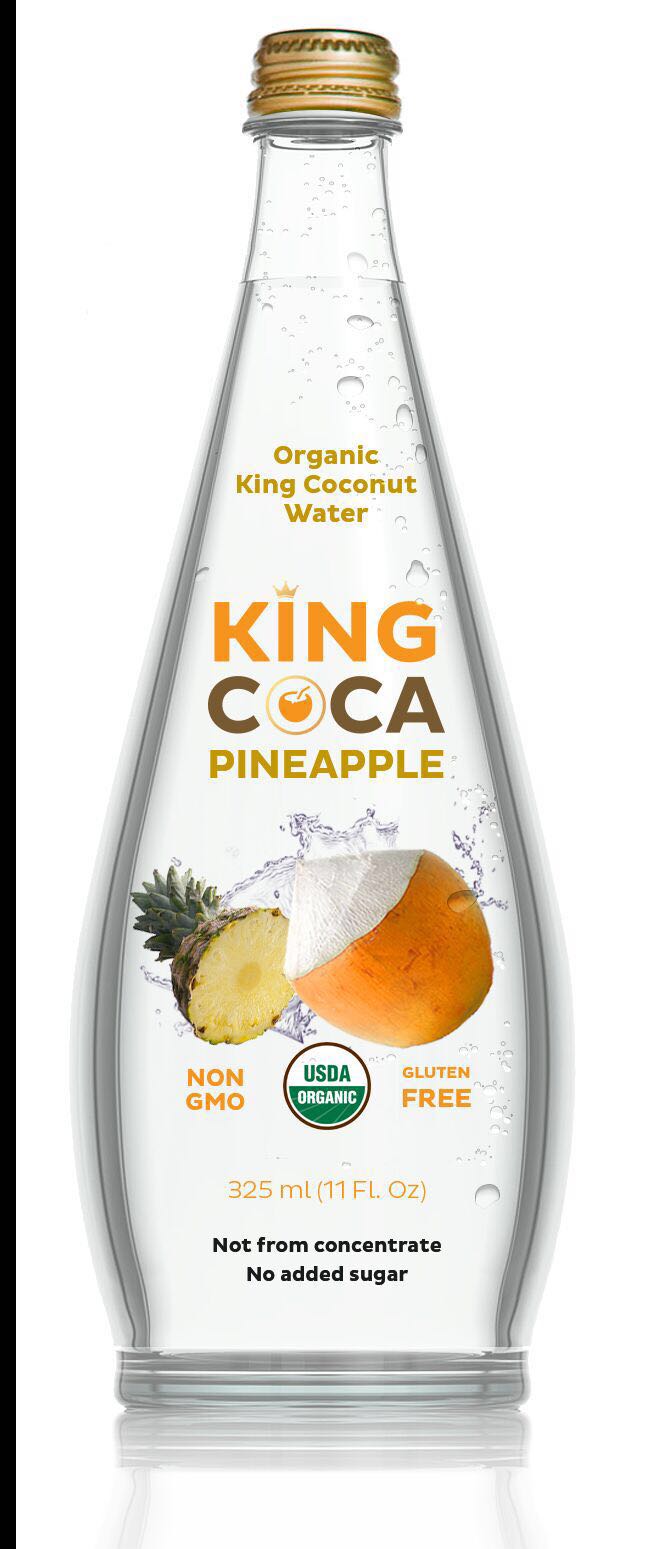
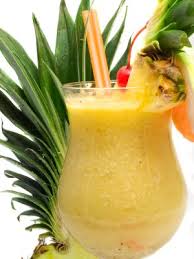
The Company firmly believes in building a strong brand identity in order to compete successfully against the giants in the food and beverage industry.
The KCBC Brand Manager will build a
global awareness of the various, Niche KCBC brands, to make King Coca Beverage
Corporation (KCBC) the largest and most profitable alternative beverage company in
the world by 2018.
KING COCA BEVERAGE CORPORATION OCCUPIES A UNIQUE POSITION, GLOBALLY, TO DOMINATE THE GLOBAL KING COCA MARKET BY BEING ABLE TO DOMINATE THE SUPPLY OF KING COCA, GLOBALLY!
THE LAUNCH OF THE WORLD'S VERY FIRST, BILLION DOLLAR, GLOBAL IPO, TARGETTING GLOBAL SOVEREIGN WEALTH FUNDS, WITH THE SUPPORT OF BOTH INDIA AND CHINA, IS CURRENTLY BEING PLANNED BY KING COCA GLOBAL OF THE U.S.A. !
WE INTEND TO DOMINATE THE GLOBAL NEUTRACEUTICAL BEVERAGE MARKET BY ELIMINATING GLOBAL HUNGER AND GLOBAL POVERTY THROUGH CROWDFUNDING IN "KING COCA COMMUNITIES" !

I love coconut water! When I’m traveling in the tropics, there is nothing better than drinking water straight from a coconut. Mother nature designed the perfect vessel for a drink that is so refreshing, slightly sweet, and keeps you hydrated in hot climates. You’ve probably heard that coconut water makes an excellent hydrating drink that replenishes electrolytes and can replace nasty chemical-filled Gatorade and Powerade – but there really is more to it than that. How do you buy the healthiest coconut water and avoid the worst?

Coconut water is one of the healthiest drinks on the planet
Coconut water contains a unique combination of B vitamins, vitamin C, micronutrients, and phytohormones that are exceptionally beneficial to your health. A scientific review of coconut water, published in the journal Molecules, highlights some of the ways that coconut water replenishes your body:
- Helps to prevent heart attacks
- Lowers high blood pressure
- Can have anti-aging effects
- Fights free radicals to help prevent cancer
- Contains trans-zeatin which can be used to treat Alzheimer’s disease or dementia
That being said, I don’t want you to think it’s okay to pick up just any coconut water off of the shelf. Packaged coconut water is really flooding into the market recently. You can find it in bottles, cartons or powdered, frozen, flavored, carbonated, and sweetened. With all these choices it can be confusing and difficult to know if you are choosing the best one.
It usually costs at least $3 bucks a bottle, so it’s not exactly affordable- and if I’m going to spend my hard earned money on some, I make sure it’s worth it! Primarily, I look for coconut water that is the least processed and still has the majority of its nutrients intact. This is always going to be directly from a fresh coconut – but, of course that’s not always available. If you haven’t already heard, Pepsico and Coca-Cola have their own versions of coconut water – (O.N.E., Zico, Naked) – and you can only imagine what the corporations have done to it.
How To Ruin Coconut Water
Using a concentrate instead of fresh juice: Some coconut water companies get away with saying their drinks contain “100% Coconut Water” that’s “All Natural” even though it’s made from a reconstituted concentrate. Just like other juices in the store, they heat fresh coconut water and reduce it to a syrup. It’s cheaper for them to import this coconut water syrup, which they later add water prior to packaging. Any juice that has been heated to this extent loses a significant amount of its nutrients and its beneficial enzymes are denatured (i.e. the enzymes don’t work anymore).
Taking water from mature coconuts: This is a biggie. Young coconuts on the tree are usually green with an abundance of water in the center that is full of nutrients. Anyone that drinks coconut water straight from a coconut is drinking out of one of these young coconuts. As they begin to age, the nutrients in the water begin to seep into the meat of the coconut, and the water becomes less nutritious. It’s essentially watered-down. This also happens when young coconuts are picked and allowed to lie on the ground in the sun, for an extended period of time. While older “mature” coconuts might be used to make coconut oil, coconut milk and other coconut products, the coconut water from older coconuts is often discarded because it’s lacking nutrients and doesn’t taste the same. As the popularity in coconut water spiked recently, companies realized that they could buy up the water from mature coconuts and could get it cheaper than young coconut water. This is why it’s important to drink young coconut water and not get scammed into drinking the watered-down and less nutritious version.
Adding “natural flavors” or sweeteners: Young coconut water is refreshing and sweet, so there is absolutely no need to flavor or sweeten it – unless you are trying to hide something. Guess what happens when they use mature coconuts for their water? It tastes acidic, so they mask this taste with natural flavors or sweeten it up with sugars. I’ve heard that some companies use a centrifuge system to remove the acidic taste, but it’s a safe assumption that if you see a plain coconut water on the shelf with any natural flavors or sweeteners added it is from mature coconuts and not worth your money.
Pasteurizing it with heat: Coconut water is very delicate, naturally perishable, and should be kept cold. Have you ever stopped to wonder why most bottled and boxed coconut waters on the shelves aren’t in the refrigerated section? I recently checked out one of these bottles and noticed it didn’t expire for 2 years! This is because most coconut water at the store is heat pasteurized, which literally means that it’s been cooked to a very high temperature to kill bacteria and extend its shelf life. It has been shown that heat also destroys some of the vitamins, minerals, and phytonutrients and also denatures enzymes – stripping its benefits and much of its flavor. If coconut water is from concentrate, this would be the second time it’s heated. Obviously, your best bet is to seek out and find unpasteurized raw coconut water. This can be hard to find, but there is another way to kill bacteria while keeping the nutrients intact: HPP (high pressure processing). Without using heat, HPP is best way to preserve the goodness in coconut water, while extending its shelf life a little to make it more available commercially.
Dipping whole coconuts in formaldehyde or sodium metabisulphite: It’s been reported that some non-organic coconuts may be preserved for transport to the U.S. by dipping them in chemicals, including formaldehyde a known carcinogen. This leads to the possibility that these chemicals seep into the coconut meat and poisons the water. Some of my favorite organic cafes avoid this by getting frozen coconut water shipped directly to them.
We called up several of the most popular coconut water companies and asked where they source their coconuts (young vs. mature), if they dip them in chemicals, how they pasteurize them, and about additives and preservatives that they may use. We got a variety of responses, and it’s almost surprising to me how much some of these companies have screwed up something as basic as coconut water. I found several brands to avoid, because they are so heavily processed that the final product barely resembles natural coconut water.
Coconut waters to avoid at all costs:
Naked Juice Coconut Water – Although it’s not from concentrate, Naked told me that they use “mature” coconut water that is flash pasteurized with heat. The plain variety doesn’t have any additives, but all of the flavored ones have added natural flavors. This is also a Pepsico brand – a company that spent over $4 Million dollars to fight GMO labels – so they aren’t getting any of my business.
O.N.E. Coconut Water – This is another Pepsico brand that is flash pasteurized with heat. The flavored waters “with a Splash of Fruit Juice” contain natural flavors and “sugar” as an ingredient. As it doesn’t say “cane sugar” on the label, this could very well be from GMO sugar beets.
Pepsico told me that they couldn’t confirm whether their sugar is GMO because:
“the exact source of the sugar in our coconut water cannot be confirmed because we source our ingredients from around the world and that information is not available at this time. Please know that all of our products comply with all applicable food laws and labeling requirements. O.N.E. Coconut Water relies on the regulatory agencies charged with safeguarding our food supply when sourcing ingredients for our products”.
They are relying on the FDA’s regulations to protect us, although the FDA themselves say that the manufacturer is responsible for ensuring the safety of the ingredients used in their products, including GMOs.
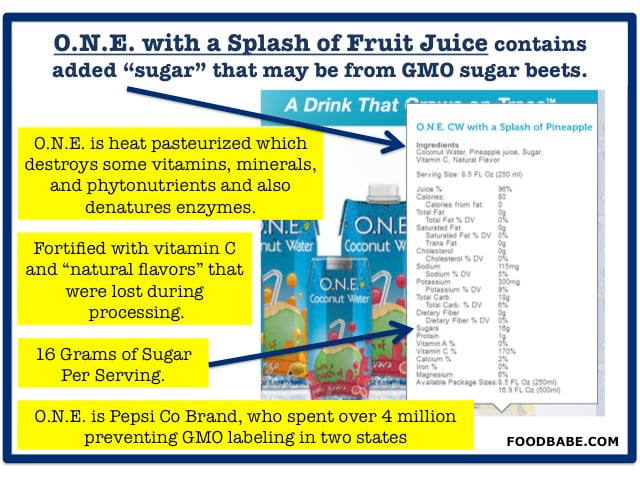
Zico – They sell two entirely different coconut waters depending on which packaging you choose. The waters in the bottles are made from concentrate and are a “blend of Asian coconuts” with natural flavors added. On the other hand, the ones in the tetra-pak cartons are not made from concentrate, have no additives, and contain only Thai coconut water that is packaged in Thailand. A bit confusing, isn’t it? While the tetra-paks (boxed) seem like a good choice, they use “Ultra High Temperature Pasteurization” to give it a long shelf life. This means it’s heated well above boiling point to 280 degrees Fahrenheit, which “kills everything” according to Scientific American, including beneficial nutrients. Plus, in case you didn’t hear the news, they were recently acquired by Coca-Cola – a big supporter of GMOs who have spent over 3.2 million to prevent GMO labeling.
CocoZona – We called and emailed them on several occasions, and they never replied to any of our questions – not even a peep! I always find it alarming when a company refuses to stand behind their product and isn’t transparent about their practices, especially since some companies have been caught lying about what’s really in the bottle. So, at this point, we know little more than what’s printed on the bottle of CocoZona, and the ingredient list reveals that it is made from concentrate. That’s enough reason to stay away from it.
Vita Coco – Don’t be fooled by all of those celebrity endorsements! Their waters are not made from concentrate, but they are all pasteurized with heat. Many of the flavored versions contain added sweeteners and the Cafe versions contain carrageenan. Even the seemingly plain 100% pure version contains added “fruit sugar.” Watch out for their coconut waters targeting kids, which are loaded with added sugar and many different natural flavors – they are not 100% coconut water! According to their website, Vita Coco Kids is also ultra high temperature pasteurized.
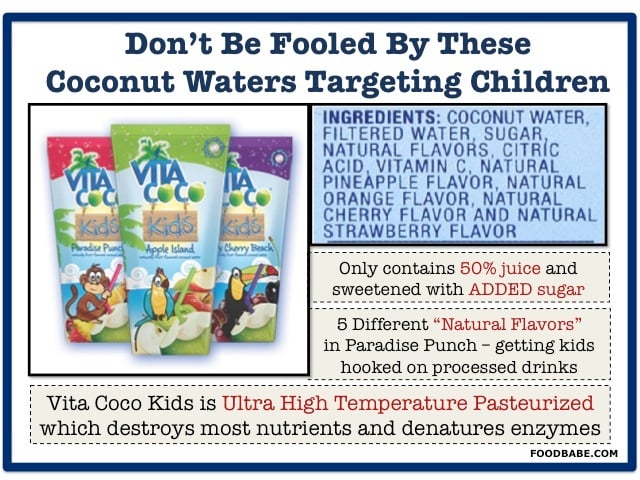
GOYA – This brand is heat pasteurized and contains added preservatives. Some versions are sweetened with sugar, which may be GMO. Because I vote with my dollars, I avoid any GOYA brand product as they spent over $56K to fight GMO labeling in California.
C2O – They told me they heat pasteurize their water up to 120 degrees celsius once the product is in the can for as long as 5 minutes. Although, they use no additives or concentrates, the length of this high heat processing puts it squarely on my avoid list.
Purity Organic – It’s made from concentrate and flash pasteurized with heat, so some of the goodness has been destroyed. It’s organic I know, but not all organic products use the best practices!
Coco Libre (Organic) – It’s made from concentrate, flash pasteurized with heat and has added “natural flavors.”
How do other popular coconut waters stack up?
Munkijo (organic) – This water isn’t from concentrate, contains no additives or added sugars and their young coconuts are sustainably grown and harvested. But I’m sorry to report they also use ultra high heat pasteurization to process their waters, so it’s far from the best on the market.
Coco Hydro by Big Tree Farms (organic) – I really like Big Tree Farms’ mission geared towards sustainability. Their unique version of coconut water is powdered and comes in packets that travel easily. So, there is no pasteurization involved, you just add water to reconstitute it. However, the process they use to evaporate the water uses heat, so it is not considered raw and some of the nutrients may be destroyed in the process.
Taste Nirvana (organic) – No concentrates or additives in this brand, and their young coconuts are sustainably grown, harvested and organic (though not labeled as such). I really like how it’s packaged in glass bottles. They are the only company that told me they use a “steam sterilization” process which is a combination of steam and pressure.
Amy & Brian (organic) – Other than the fact that they flash pasteurize the water, all other aspects are good – no additives, no added sugars, no concentrates. They also told me that their young coconuts are not treated with any chemicals or pesticides. I have to admit though, I’m not a fan of the cans they are in, even if they are BPA-free.
Harvest Bay (some varieties are certified organic) – They flash pasteurize their water for about 2 seconds at 120 degrees, and it’s not from concentrate. Some of their waters are now organic, and they are all non-GMO project verified. Although they add no sugars or additives to their plain version, most flavored varieties contain added sugar or natural flavors, so I’d avoid those.
Whole Foods 365 – They confirmed they don’t use a concentrate, however they heat pasteurize their water which comes “from around the world depending on availability”. Their water is also packaged in cans, which I don’t like!
Trader Joe’s – Their water is not from concentrate, but it is pasteurized. I have yet to hear back from them in regards to how they pasteurize their water (whether they use flash or ultra processing). They fortify their water with added vitamin C, which is a red flag that it has been heavily processed.
My top picks for packaged coconut water:
***This chart contains examples of the coconut waters we researched, however, there are many more available on the market or may be available in your neck of the woods. Please use this post as a guide to find the best coconut water in your area.***
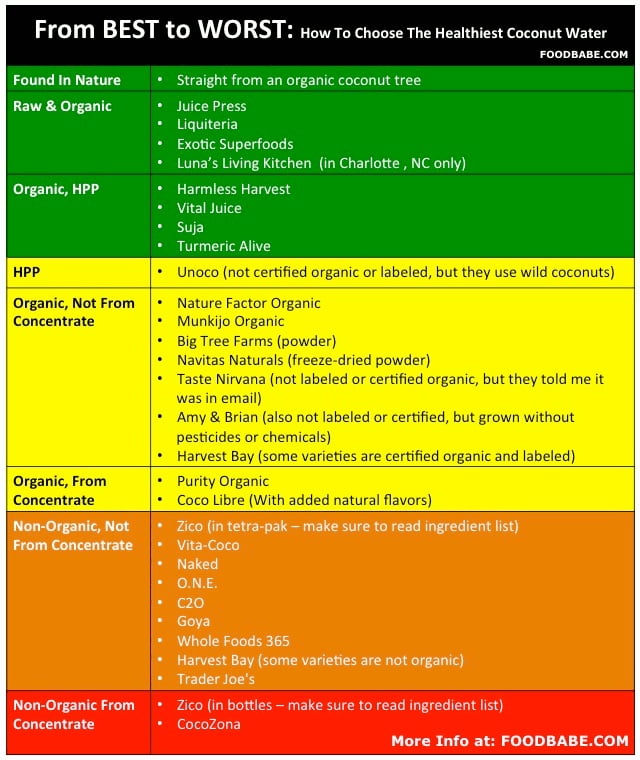
While the best coconut water is straight from a young coconut picked from a tree, these packaged waters below are as close to the real thing as you can get. They don’t use any heat processing or concentrates, so they aren’t cooking your coconut water. Some of them use HPP to kill bacteria, and a couple of these brands serve it up completely raw and unpasteurized.
Harmless Harvest (organic) – I’ve written about this brand before, and it’s no secret that they are my favorite. I had the pleasure of meeting with the founders of Harmless Harvest and I’m blown away with how open and honest they are about everything. They’ve become a success not because of marketing, but because of their good practices. In fact, they hardly spend any money on marketing at all (and bloggers are not compensated either). They source their young coconuts from small organic agroforestry farms that pay a fair wage to their workers. The coconuts are then frozen and shipped to the U.S. for packaging, after which they use HPP processing to kill bacteria and extend the shelf life to 60 days. Because it’s so minimally processed, some of the waters turn pink when the naturally occurring antioxidants or phenols are exposed to light – and you won’t find this in pasteurized coconut water. You can find this at Whole Foods and most natural food stores in the refrigerator section.
Juice Press (organic) – This water is totally raw. It’s not pasteurized or processed with HPP. Their coconuts are shipped frozen to the store and then they ship it fresh to you with a 3 or 4 day shelf life.
Exotic Superfoods (organic) – Another fave, this water is 100% organic and raw. It is not processed with any heat or HPP – but it’s kept frozen to preserve freshness.
Liquitera (organic) – This bottled raw coconut water is also organic, without any pasteurization. It’s only available at their stores in New York.
Vital Juice (organic) – It’s never heated or frozen, and it’s preserved with HPP, 100% organic and non-GMO project verified. It is currently only available at stores in Washington and Oregon with plans of expansion, and you can also order it online on Amazon.
Unoco (wild coconut) – Made from wild coconuts (not from a plantation) and processed with HPP without any additives. It’s only available in California right now.
Suja (organic) – Suja makes a coconut water blend, Tropicaloe, which is made from freeze-dried coconut water mixed with pineapple, apple, aloe, lime, mint and spinach juices, all preserved with HPP. This juice is exclusively sold at Whole Foods stores.
Keep in mind that while I think coconut water is amazing, I don’t drink it every day, I use it as a treat or on days I am very active and sweat hard!
If you know someone who loves coconut water or needs a great substitute for soda, Gatorade, Powerade or other unhealthy drinks – please share this post!
We must educate as many people as possible about their choices to change the marketplace. When we change the marketplace and start spending our money on the best and safest brands, we change the world!
Xo,
Vani


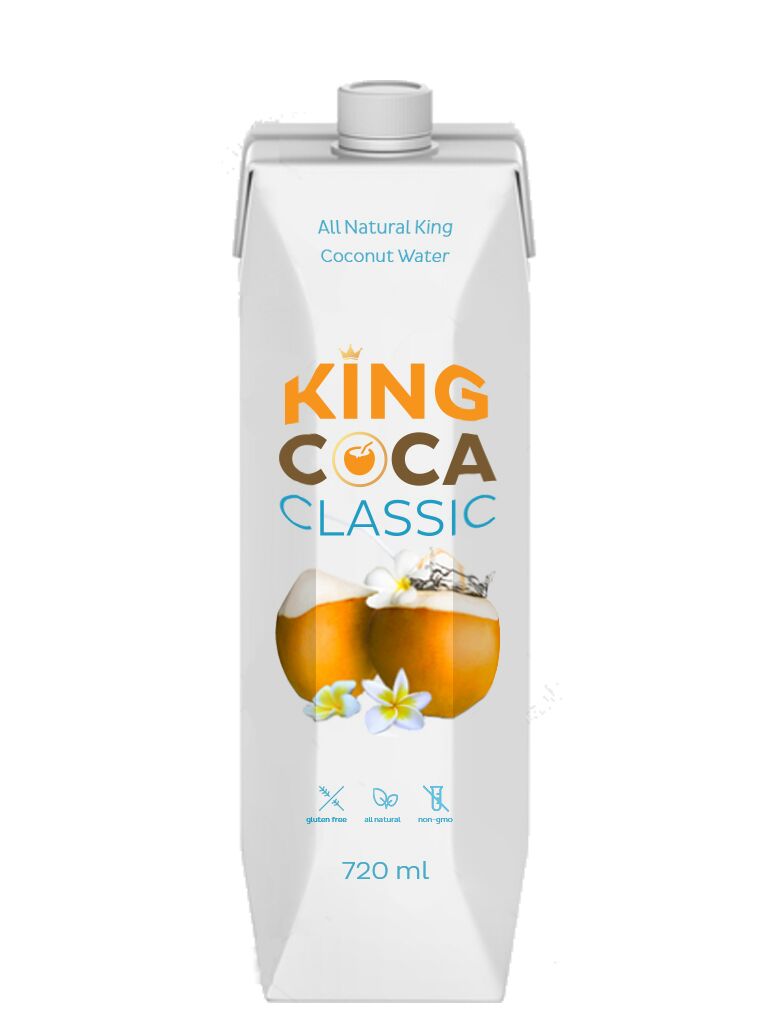
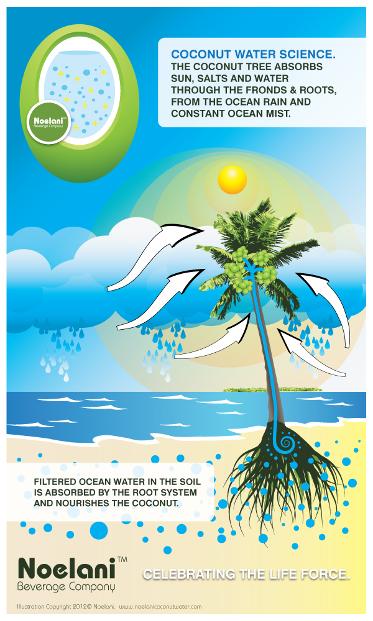
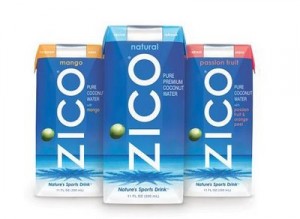





KING POWER
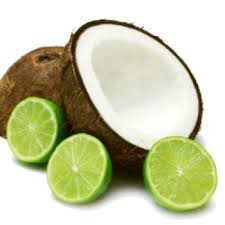
PINA COCA
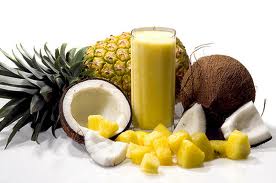

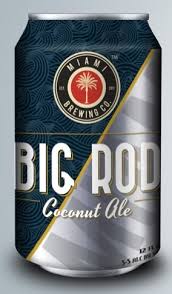
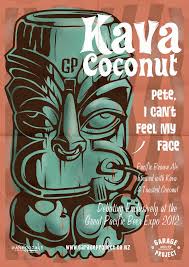



WWW.SINGHAPOWER.COM
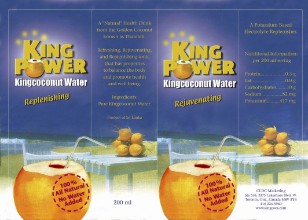
"THE BEVERAGE OF KINGS AND WORLD
CHAMPIONS"



MARKETING@CRICKETCALENDARS.COM













FUNDRAISING@SINGHAPOWER.COM


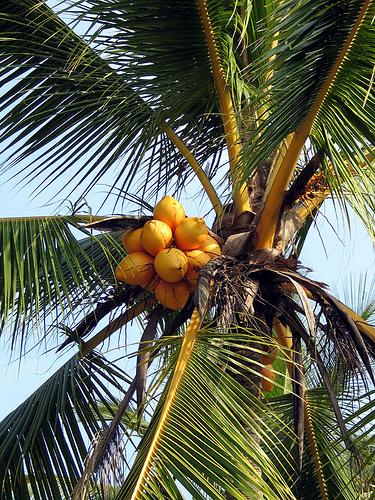
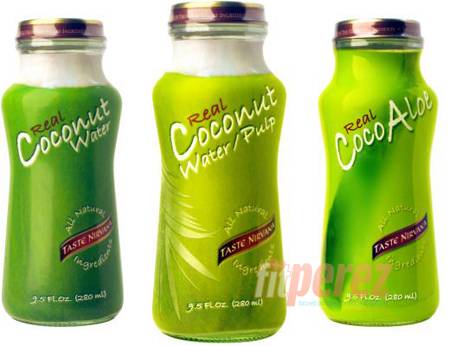
COCA LOCA
